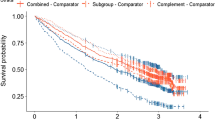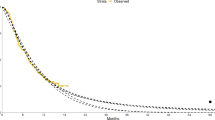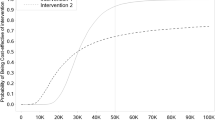Abstract
Purpose
Previous research using numerical methods suggested that use of a cohort-based model instead of an individual-based model can result in significant heterogeneity bias. However, the direction of the bias is not known a priori. We characterized mathematically the conditions that lead to upward or downward bias.
Method
We used a standard three-state disease progression model to evaluate the cost effectiveness of a hypothetical intervention. We solved the model analytically and derived expressions for life expectancy, discounted quality-adjusted life years (QALYs), discounted lifetime costs and incremental net monetary benefits (INMB). An outcome was calculated using the mean of the input under the cohort-based approach and the whole input distribution for all persons under the individual-based approach. We investigated the impact of heterogeneity on outcomes by varying one parameter at a time while keeping all others constant. We evaluated the curvature of outcome functions and used Jensen’s inequality to determine the direction of the bias.
Results
Both life expectancy and QALYs were underestimated by the cohort-based approach. If there was heterogeneity only in disease progression, total costs were overestimated, whereas QALYs gained, incremental costs and INMB were under- or overestimated, depending on the progression rate. INMB was underestimated when only efficacy was heterogeneous. Both approaches yielded the same outcome when the heterogeneity was only in cost or utilities.
Conclusion
A cohort-based approach that does not adjust for heterogeneity underestimates life expectancy and may underestimate or overestimate other outcomes. Characterizing the bias is useful for comparative assessment of models and informing decision making.



Similar content being viewed by others
References
Sculpher M. Subgroups and heterogeneity in cost-effectiveness analysis. Pharmacoeconomics. 2008;26(9):799–806.
Groot Koerkamp B, Weinstein MC, Stijnen T, Heijenbrok-Kal MH, Hunink MG. Uncertainty and patient heterogeneity in medical decision models. Med Decis Making. 2010;30(2):194–205.
Groot Koerkamp B, Stijnen T, Weinstein MC, Hunink MG. The combined analysis of uncertainty and patient heterogeneity in medical decision models. Med Decis Making. 2011;31(4):650–61.
Grutters JP, Sculpher M, Briggs AH, Severens JL, Candel MJ, Stahl JE, De Ruysscher D, Boer A, Ramaekers BL, Joore MA. Acknowledging patient heterogeneity in economic evaluation: a systematic literature review. Pharmacoeconomics. 2013;31(2):111–23.
Siebert U, Alagoz O, Bayoumi AM, et al. State-transition modeling: a report of the ISPOR-SMDM Modeling Good Research Practices Task Force-3. Med Decis Making. 2012;32(5):690–700.
Coyle D, Buxton MJ, O’Brien BJ. Stratified cost-effectiveness analysis: a framework for establishing efficient limited use criteria. Health Econ. 2003;12(5):421–7.
Espinoza MA, Manca A, Claxton K, Sculpher MJ. The value of heterogeneity for cost-effectiveness subgroup analysis: conceptual framework and application. Med Decis Making. 2014;34(8):951–64.
Basu A, Meltzer D. Value of information on preference heterogeneity and individualized care. Med Decis Making. 2007;27(2):112–27.
Weinstein MC. Recent developments in decision-analytic modelling for economic evaluation. Pharmacoeconomics. 2006;24(11):1043–53.
Caro JJ, Möller J. Decision-analytic models: current methodological challenges. Pharmacoeconomics. 2014;32:943–50.
Kuntz KM, Goldie SJ. Assessing the sensitivity of decision-analytic results to unobserved markers of risk: defining the effects of heterogeneity bias. Med Decis Making. 2002;22:218–27.
O’Mahony JF, van Rosmalen J, Zauber AG, van Ballegooijen M. Multicohort models in cost-effectiveness analysis: why aggregating estimates over multiple cohorts can hide useful information. Med Decis Making. 2013;33(3):407–41.
Briggs A, Claxton K, Sculpher M. Decision modeling for health economic evaluation. Oxford: Oxford University Press; 2006.
Beck JR, Pauker SG. The Markov process in medical prognosis. Med Decis Making. 1983;3:419–58.
Briggs A, Sculper M. An introduction to Markov modeling for economic evaluation. Pharmacoeconomics. 1998;13:397–409.
Soares MO, Canto E, Castro L. Continuous time simulation and discretized models for cost-effectiveness analysis. Pharmacoeconomics. 2012;30(12):1101–17.
van Rosmalen J, Toy M, O’Mahony JF. A mathematical approach for evaluating Markov models in continuous time without discrete-event simulation. Med Decis Making. 2013;33:767–79.
Gradshteyn IS, Ryzhik IM. Tables of integrals, series, and products. 6th ed. San Diego: Academic; 2000. p. 1101.
Needham T. A visual explanation of Jensen’s inequality. Am Math Mon. 1993;100:768–71.
Kulkarni VG. Modeling and analysis of stochastic systems. London: Chapman & Hall/CRC; 1995.
Chiang A. Fundamental methods of mathematical economics. New York: McGraw-Hill; 1974.
Author contributions
Elamin Elbasha was primarily responsible for writing the manuscript in close cooperation with Jagpreet Chhatwal. Both authors read, edited and approved the final manuscript. Elamin Elbasha is the overall guarantor for the content.
Conflicts of interest
The authors have no conflicts of interest to declare.
Author information
Authors and Affiliations
Corresponding author
Electronic supplementary material
Below is the link to the electronic supplementary material.
Appendix
Appendix
The model can be represented by a system of ordinary differential equations and solved analytically to determine the number of persons in each state and the overall expected value of each outcome. The transition matrix Q and the transition probability matrix B of a continuous-time Markov chain are related according to the Kolmogorov forward differential equations:
The matrices B and Q in this case are given by:
where p denotes the disease progression rate per year, h denotes efficacy, d denotes the disease-specific death rate per year and m denotes the all-cause mortality rate per year. The two matrices, B and Q, are related to each other according to:
where exp denotes the matrix exponential.
The state probability distribution of the Markov chain at time t, \( x\left( t \right) = \left[ {B_{11} \left( t \right),\,B_{12} \left( t \right),\,B_{13} \left( t \right)} \right] = \left[ {W\left( t \right),\, S\left( t \right),\,D\left( t \right)} \right], \) satisfies the following equation:
where x 0 is the initial distribution [20].
Assuming the Markov chain starts in the Well health state, \( x\left( 0 \right) = \left[ {1,0,0} \right], \) the number of persons in a given health state at time t evolves over time according to:
where W is the number of persons in the Well state, S is the number of persons in the Disease state and D is the number of persons in the Dead state.
This is a block-recursive system, which can be solved as follows (see reference [21], Chapter 14, Section 14.1). Equation (A.1) can be rewritten as:
Using standard integration methods, we obtain \( \ln W\left( t \right) - \ln W\left( 0 \right) = - \left[ {\left( {1 - h} \right)p + m} \right]t, \) noting that \( \ln W\left( 0 \right) = \ln 1 = 0, \) we have:
Substituting Eq. A.4 into Eq. A.2 yields:
This is a nonhomogeneous equation with a variable coefficient whose general solution is given by reference [21], Chapter 14, Section 14.3.
where the arbitrary constant A can be determined from the initial condition, S(0) = 0, as:
Substituting the value of A, we obtain:
The number of persons in the Dead state can be recovered from Eqs. (A.4) and (A.6), using the equation:
Assuming a lifetime horizon (i.e. infinite time), discounted (at rate r per year) the QALYs are:
where q denotes the decrement in the quality of life of a sick person.
Undiscounted life expectancy is obtained from the above expression by setting r = q = 0. The discounted disease cost is:
where c denotes the cost of disease per year.
The incremental discounted QALYs are:
Similarly, the incremental discounted disease costs are:
Denoting the maximum WTP for a QALY by λ (also referred to as the cost-effectiveness threshold), the intervention has an INMB of:
where I denotes the one-time cost of the intervention.
Rights and permissions
About this article
Cite this article
Elbasha, E.H., Chhatwal, J. Characterizing Heterogeneity Bias in Cohort-Based Models. PharmacoEconomics 33, 857–865 (2015). https://doi.org/10.1007/s40273-015-0273-z
Published:
Issue Date:
DOI: https://doi.org/10.1007/s40273-015-0273-z




